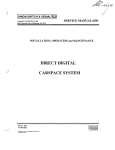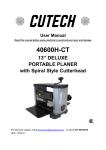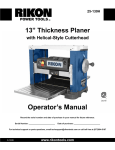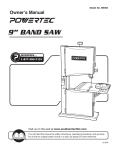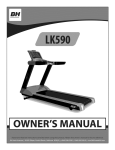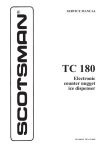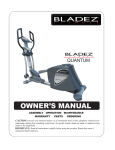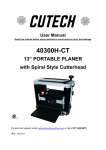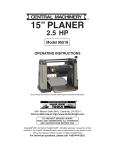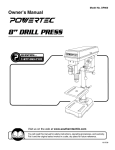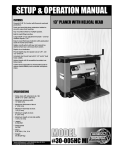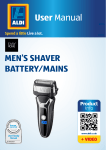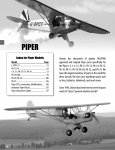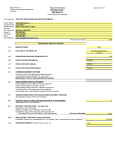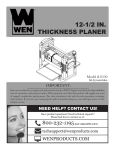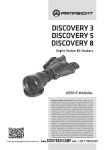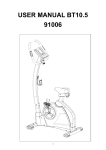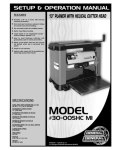Download user manual
Transcript
Model No. PL1300 Owner’s Manual 13” PLANER WITH BUILT-IN DUST COLLECTION QUESTION... 0 1•877•393•7121 Visit us on the web at www.southerntechllc.com You will need this manual for safety instructions, operating procedures, and warranty. Put it and the original sales invoice in a safe, dry place for future reference. 09-0911 TABLE OF CONTENTS SECTION PRODUCTION SPECIFICATIONS PAGE SAFETY RULES 1 Horsepower (Maxmum Developed)........................... 2.4 HP Voltage..........................................................................120 V Work Preparation Work Area Preparation Tool Maintenance Tool Operation Amperes..............................................................................1 5 Hertz...................................................................................60 ASSEMBLY 2 Motor RPM.........................................................17,500 RPM Unpacking Install Elevation Crank Handle Attach Dust Collection Bag Mount Planer Power Source Grounding Instructions Extension Cords Electrical Connections OPERATION5 Table Size.......................................................13” x 10-1/4” Blade Width....................................................................13” Maximum Depth of Cut................................................3/32” Cuts per Minute........................................................16,000 Dust Collection Port....................................................2-1/2” 5 Description Specifications Safety Precautions Rollercase Lock Rollercase Height Adjustment Depth of Cut Thickness Pre-set Gauge ON/OFF Switch Circuit Breaker Before Operating the Planer Operate the Planer MAINTENANCE Phase............................................................................Single 9 Check and Replace the Blades Inspect and Replace the Motor Brushes Adjust Rollercase Level Replace V-Belt Clean and Lubrication TROUBLESHOOTING 11 PARTS ILLUSTRATION & LIST 13 WARRANTY 17 SAFETY RULES WARNING For your own safety, read and understand all warnings and operating instructions before using any tool or equipment. WARNING Some dust created by operation of power tool contains chemicals known to the State of California to cause cancer, birth defects or other reproductive harm. To reduce your exposure to these chemicals: work in a well ventilated area and work with approved safety equipment. Always wear OSHA/NIOSH approved, properly fitting face mask or respirator when using such tools. WARNING Failure to follow these rules may result in serious personal injury. Remember that being careless for even a fraction of a second can result in severe personal injury. WORK PREPARATION • Wear proper apparel. Do not wear loose clothing, gloves, neckties, rings, bracelets or other jewelry which may get caught in moving parts of the tool. • Nonslip protective footwear is recommended. • Wear protective hair covering to contain long hair. • Wear eye and hearing protection. Always use safety glasses. Eye protection equipment should comply with ANSI Z87.1 standards. Hearing equipment should comply with ANSI S3.19 standards. • Wear face mask or dust mask if operation is dusty. • Be alert and think clearly. Never operate power tools when tired, intoxicated or when taking medications that cause drowsiness. WORK AREA PREPARATION • Keep work area clean. Cluttered work areas and benches invite accidents. • Work area should be properly lighted. • Do not use the machine in a dangerous environment. The use of power tools in damp or wet locations or in rain can cause shock or electrocution. • Three-prong plug should be plugged directly into properly grounded, three-prong receptacle. • Use the proper extension cord. Make sure your extension cord is in good condition and should have a grounding prong and the three wires of extension cord should be of the correct gauge. • Keep children and visitors away. Your shop is a potentially dangerous environment. Children and visitors can be injured. •Make your workshop childproof with padlocks, master switches or remove switch keys to prevent any unintentional use of power tools. 1 TOOL MAINTENANCE • Turn the machine "OFF", and disconnect the machine from the power source prior to inspection. • Maintain all tools and machines in peak condition. Keep tools sharp and clean for best and safest performance. • Follow instructions for lubricating and changing accessories. • Check for damaged parts. Check for alignment of moving parts, binding, breakage, mounting and any other condition that may affect tool's operation. • Poorly maintained tools and machines can further damage the tool or machine and/or cause injury. • A guard or any other part that is damaged should be repaired or replaced. Do not perform makeshift repairs. TOOL OPERATION • Avoid accidental start-up. Make sure that the tool is in the “OFF” position before plugging in. • Use the right tool for your job. Do not force your tool or attachment to do a job for which it was not designed. • Disconnect tool when changing parts. • Don't force the workpiece on the machine. Damage to the machine and/or injury may result. • Never leave tool running unattended. Turn the power off and do not leave tool until it comes to a complete stop. • Do not overreach. Loss of balance can make you fall into a working machine, causing injury. • Never stand on tool. Injury could occur if the tool tips, or if you accidentally contact the cutting tool. • Know your tool. Learn the tool’s operation, application and specific limitations before using it. • Use recommended accessories. Use of improper accessories may cause damage to the machine or injury to the user. • Handle workpiece correctly. Keep hands away from moving parts. • Turn tool off if it jams. CAUTION: Think safety! Safety is a combination of operator common sense and alertness at all times when tool is being used. WARNING Do not attempt to operate tool until it is completely assembled according to the instructions. ASSEMBLY 2 UNPACKING • Check freight damage before opening the package. If freight damage is noticed, file claim with the carrier immediately. • Check for complete part list. Contact Customer Service Center immediately for missing parts. • This Planer comes mostly assembled. It requires some additional assembling, installation, and adjustment before use. • Locate the following parts before assembling: A. Planer B. Elevation Crank Handle Assembly C. 6mm Flat Washer D. 6-1.0 x 20mm Socket Pan Head Bolt E. 4mm Hex Wrench F. Dust Chute G. Magnet (2) H. Dust Collection Wire I. Dust Bag Clamp J. Dust Bag INSTALL ELEVATION CRANK HANDLE Refer to Figure 2 and 3 • The planer handle can be installed either to the top-right or top-left of the planer. • Remove plug from the end of elevation screw (a) • Insert handle (b) onto elevation screw top (a). • Secure handle with bolt using the enclosed wrench (c). Figure 2 a Figure 3 c b 0 Figure 1 Unpackaging ATTACH DUST COLLECTION BAG A Refer to Figure 1 and 4 • Install the Dust Chute (F) by slipping it over the Dust Port. Tighten the screw on the Dust Chute (F). • Insert Dust Bag Wire (H) through a small hole on the sleeve of Dust Bag (J). H B C D G E F Figure 4 - 1 I J • Draw the open end of Dust Bag (J) sleeve through the ring of Dust Bag Wire (H). • The planer must be bolted to a firm and level surface. • There must be enough clearance for the moving work piece during operation. There must be enough room for safety operation of the machine. ASSEMBLY Figure 4 - 2 Figure 5 – Mounting Holes 3 • Place Clamp (I) over Dust Bag (J) Sleeve. Figure 4 - 3 Mounting Holes POWER SOURCE WARNING • Slide Sleeve with Clamp (I) and Dust Bag Wire (H) Ring over Dust Chute (F). Figure 4 - 4 Do not connect to the power source until the machine is completely assembled. The machine is wired for 120 volts, 60 HZ alternating current. Before connecting the machine to the power source, make sure the switch is in the "OFF" position. Running the unit on voltages which are not within range may cause overheating and motor burn-out. Heavy loads require that voltage at motor terminals be no less than the voltage specified on nameplate. • Power supply to the motor is controlled by a locking rocker switch. Remove the key to prevent unauthorized use. GROUNDING INSTRUCTIONS WARNING • Secure Dust Bag (J) in position. Rotate the handle on the Clamp (I) to adjust the clamp size so it can slide over the Dust Chute (F). Press the handle to tighten the Clamp (I). • The Dust Bag (J) should be secured on the Dust Chute (F) now. MOUNT PLANER Refer to Figure 5 • The planer must be installed in a well-lighted area with correct power supply. • Eight mounting holes are on the base of planer. If pre-drilled holes do not exist on the bench surface, drill four holes. • Planer can be installed on either a workbench or a tool stand by using bolts, lock washers, and hex nuts. (mounting hardware not included) Improper connection of equipment grounding conductor can result in the risk of electrical shock. • The machine should be grounded while in use to protect operator from electrical shock. • In the event of an electrical short circuit, grounding reduces the risk of electrical shock by providing an escape wire for the electricity. • This machine is equipped with an approved 3-conductor cord rated at 150V and a 3-prong grounding type plug (Figure 6) for your protection against shock hazards. • Grounding plug should be plugged directly into a properly installed and grounded 3-prong grounding-type receptacle, as shown (Figure 6) • The plug must be plugged into an outlet that is properly installed and grounded in accordance with all local codes and ordinances. • Check with a qualified electrician or service personnel if these instructions are not completely understood or if in doubt as to whether the tool is properly grounded. ASSEMBLY • Do not modify plug provided. If it will not fit in outlet, have proper outlet installed by a qualified electrician. Use only 3-wire extension cords, that have 3-prong grounding type plugs and matching 3-conductor receptacles that accept the machine's plug, as show in Figure 6 Figure 6 - 3-Prong Receptacle 4 Grounded outlet Box have 3-prong grounding type plugs and 3-pole receptacles which accept the tool plug. When using an extension cord, make sure to use one heavy enough to carry the current of the machine. An undersized cord will cause a drop in the voltage, resulting in loss of power and overheating. Use the table to determine the minimum wire size (A.W.G.) extension cord. Extension Cord Length Wire Size . . . . . . . . . . . . . . . . . . . . . . . . . . . . . . . . A.W.G. Up to 25 ft. . . . . . . . . . . . . . . . . . . . . . . . . . . . . . . . . . . . 18 25 to 50 ft. . . . . . . . . . . . . . . . . . . . . . . . . . . . . . . . . . . . 16 NOTE: Using extension cords over 50 ft. long is not recommended. 3 - Prong Plug MOTOR Grounding Prong WARNING Do not permit fingers to touch the terminals of plug when installing or removing from outlet. • Inspect tool cords periodically, and if damaged, have repaired by an authorized service facility. • The conductor with insulation having an outer surface that is green with or without yellow stripes is the equipment-grounding conductor. If repair or replacement of the electric cord or plug is necessary, do not connect the green (or green and yellow) wire to a live terminal. A temporary 3-prong to 2-prong grounding adapter (see Figure 7) may be used to connect this plug to a matching 2-conductor receptacle as shown in figure 7. The temporary adapter should be used only until a properly grounded outlet can be installed by a qualified electrician. Figure 7 - 3-Prong Receptacle Grounded outlet Box Adapter Grounding Means In Canada, the use of temporary adapter is not permitted by the Canadian Electric Code. Where permitted, the rigid green tab or terminal on the side of the adapter must be securely connected to a permanent electrical ground such as a properly grounded water pipe, a properly grounded outlet box or a properly grounded wire system. • Many cover plate screws, water pipes and outlet boxes are not properly grounded. To ensure proper ground, grounding means must be tested by a qualified electrician. EXTENSION CORDS Use proper extension cords. Make sure the extension cord is in good condition. Use only 3-wire extension cords Planer is supplied with a 2.4 HP motor installed. The 120 Volt AC universal motor has the following specifications: Horsepower (Maximum Developed) . . . . . . . . . . . .2.4 HP Voltage . . . . . . . . . . . . . . . . . . . . . . . . . . . . . . . . . . . . .120 Amperes . . . . . . . . . . . . . . . . . . . . . . . . . . . . . . . . . . . . .15 Hertz. . . . . . . . . . . . . . . . . . . . . . . . . . . . . . . . . . . . . . . .60 Phase . . . . . . . . . . . . . . . . . . . . . . . . . . . . . . . . . . . Single Cutterhead RPM . . . . . . . . . . . . . . . . . . . . . . . . . . . .8,000 ELECTRICAL CONNECTIONS WARNING • Turn the switch off and disconnect the machine from power source before performing any repair or maintenance work. • Some electrical wiring and connection work must be performed by qualified electrician in accordance with local regulations. • Scheme of the motor and electric wiring inside this machine is shown in Figure 8 • There is a green grounding wire fastened to the frame of the machine to provide Shock Protection. Do not disconnect the Grounding Wire from the frame. • The Motor is rated for used at 120 Volts. • Connect this machine to 3-Conductor Power outlet with appropriate rating only. • Use only 3-pronged Extension Power Cord with appropriate rating with this machine. • When change the power cord, use only 3-pronged Power Cord with appropriate rating. • The Power switch is a Single Pole Rocker switch with Locking Mechanism. Remove the Key when not in use to prevent accidents. Figure 8 Wiring Schematic OPERATION DESCRIPTION POWERTEC PRO 13” planer handles workpiece up to 13” (330 mm) wide and 6” (152 mm) thick. The planer features a powerful 15 amp, 2.4 HP (max. developed) motor with overload protection, built-in dust collection for fast removal of wood chips, rollercase lock for uniform thickness, depth-of-cut gauge and 6 pre-set depth gauge setting for convenient and consistent set-up, sturdy four-post design for snipeless planing, easy blade change, top rollers for workpiece return and larger extension tables with rollers for smooth operation. SPECIFICATIONS Maximum Cutting Width ………………..…….13” (330 mm) Max Cutting Height ………………………..……6” (152 mm) Cutting Depth for Width from 0” to 6”……....3/32” (2.4 mm) Cutting Depth for Width from 6” to 13”……..1/16” (1.6 mm) Cuts per Minute…………………………………….….16,000 Feed Rate ………………………………………….…19 FPM Table Material ………………………………..Stainless Steel Table Size ……………….13” x 10-1/4” (330 mm x 260mm) Table Size with Extension.....13” x 24-5/8” (330 mm x 625 mm) WARNING 5 • Turn switch off and disconnect power whenever planer is not in use. • Keep planer maintained. Follow maintenance instructions. ROLLERCASE LOCK Refer to Figure 9 • Rollercase Lock is the locking mechanism that prevents rollercase from movement during planning operation. The rollercase lock lever is located on the right side panel, between the side panel and the rollercase. It is easily visible from the front of planer. • To lock the rollercase, pull down the rollercase lock lever. To unlock the rollercase, lift up the Rollercase Lock Lever. • Always use rollercase lock for smooth planning and uniform thickness. • Always unlock the rollercase lock before adjusting the rollercase height. The Locking mechanism will wear out prematurely if excessive force is used to move the rollercase while locked. Figure 9 For our own safety, read the entire operating manual and safety instructions before using this tool. SAFETY PRECAUTIONS • Be aware of general power tool safety. Make sure all the safety rules are understood. • Disconnect the machine from power source whenever adjusting or replacing any parts. • Do not plug in unless switch is in the “OFF” position. • Keep hands away from all moving parts. • Wear eye protection or face shield during operation. • Make sure all mobile parts move freely and are free from interference. • Keep blades sharp, aligned and properly attached cutterhead. • Properly secure the blades in the cutterhead. • Never turn the machine “ON” with the workpiece contacting the cutterhead. • Never make cuts deeper than 3/32” (2.4mm) to prevent kickback. • Do not force cut. Slowing or stalling will overheat the motor. • Do not perform planing on workpiece shorter than 5”, narrower than ¾”, wider than 13” or less than 1/8” thick. • Properly support long or wide workpieces. • Do not perform a workpiece that is warped, contains knots, or is embedded with foreign objects (nails, staples, etc) to prevent kickback. • Do not feed a workpiece into the planer outfeed table. • Do not allow anyone to stand or cross in line of cutterhead rotation. Kickback or thrown debris will travel in this direction. Rollercase Lock Lever ROLLERCASE HEIGHT ADJUSTMENT Refer to Figure 10 • Rollercase is the centerpiece of the planer machine. It contains motor, cutterhead with blades, infeed and outfeed rollers, dust collection assembly, and depth-of-cut gauge. • Unlock the rollercase lock before moving the rollercase up or down. • The rollercase can be moved up or down precisely by rotating the elevation crank handle on the top of planer machine. The elevation crank handle can be installed on either right or left side of the planer top. One complete turn of elevation crank handle is equivalent to 1/16” movement of rollercase in either direction. Elevation Crank Handle 0 Elevation Depth-of-Cut Gauge DEPTH OF CUT Refer to Figure 11 • Thickness pre-set gauge is a knob with scale that shows six settings: 1/8”, ¼”, ½”, ¾”, 1”, and 1-1/4”. It is located at bottom of right side panel, on right side of the planer machine. 1 2/ ” THICKNES PRE-SET GAUGE Figure 11 1/ 4” 1/ 8” Refer to Figure 10 • The depth-of-cut is the thickness of wood material removed from the surface of workpiece during each pass. The depth-of-cut is determined by the relative position of rollercase to the top of workpiece. Depth-of-cut can be easily measured and adjusted with depth-of-cut gauge. • Depth-of-cut gauge is the small measuring device located on the right lower corner of rollercase front. The reading ranges from 0” to 3/32”. • To use the depth-of-cut gauge, place the workpiece under the gauge. Crank down the rollercase until it touches the workpiece. Now watch the gauge while carefully move the rollercase up and down, until the desired depth-of-cut reading appears. • To protect long use life of motor and cutterhead unit, the recommended maximum depth-of-cut are: 3/32” for workpiece up to 6” wide 1/16” for workpiece from 6” to 13” wide • Depth-of-cut gauge is calibrated in factory and should have reasonable accuracy. For woodworking of precision, use of calipers after each planning is recommended. 3 / 4” Figure 10 OPERATION • Use thickness pre-set gauge to set the desired thickness of the final finished product. • Thickness pre-set gauge works by stopping the rollercase from moving any lower once it reaches the pre-set thickness. The workpiece may need to pass the planer several times before reach the desired final thickness. But the thickness pre-set gauge will ensure the final finish product is not over done. This makes the whole planing process easier and faster. This is especially useful and efficient when processing several pieces of wood product with the same desired thickness. • Thickness pre-set gauge is calibrated in factory and should have reasonable accuracy. For woodworking of precision, use of calipers after each planning is recommended. To Set the Thickness Pre-set Gauge: • With the machine turned off, raise the rollercase until it is slightly higher than the intended workpiece. • Place the workpiece below the Rollercase to check that it can pass under the rollercase easily. • Turn the control knob of thickness pre-set gauge to the desired setting. • Now the rollercase will stop moving lower once it reaches the set thickness. To Reset the Thickness Pre-set Gauge: • With the machine turned off, use elevation crank handle to raise the rollercase by a few turns. This is to ensure the gauge is not jammed and is ready to be reset. • Repeat the same procedures as to set the thickness pre-set gauge. 11/8” 1” 6 • There is an elevation scale at the front of left side panel. It has a pointer with English and Metric scale. The reading is the height of cutterhead from the table platform. Therefore, the elevation scale setting represents the approximate thickness of the workpiece after planning. • Elevation scale is calibrated in factory and should have reasonable accuracy. For woodworking of precision, use of calipers after each planning is recommended. ON/OFF SWITCH Refer to Figure 12 and 13 The ON/OFF switch is located on the front of planer. To turn the machine ON, pull the switch to the up position. To turn the machine OFF, push the switch to the down position. NOTE: When the machine is not in use, the machine should be locked in the “OFF” position to prevent unauthorized use. • To lock the machine, turn the switch to the “OFF” position. Figure 12 – ON/OFF Switch Figure 13 0 Circuit Breaker ON/OFF Switch CIRCUIT BREAKERR Refer to Figure 13 • This machine has a circuit breaker installed next to the main power switch. The circuit breaker protects the motor unit by shutting off the power supply when excessive electric current is detected. If the circuit breaker is tripped, the machine will not power on. • Before reset of circuit breaker, check motor, switch, and line connection for short circuit or faulty components. • To reset the circuit breaker, Turn the switch to "OFF" position. Then press the circuit breaker reset button next to the main switch. BEFORE OPERATING THE PLANER •Understand the machine function and observe all the safety measurement. •In general, the desired depth-of-cut and final thickness of workpiece are determined before planing. Since there is limit of maximum depth-of-cut, the workpiece may have to pass the machine several times before reach the desired final thickness. •The Rollercase has to be lowered manually before each pass, if more than one pass are necessary. •The planer machine setting involves readings of elevation scale, depth-of-cut gauge, thickness pre-set gauge, and operation of rollercase elevation crank handle and thickness pre-set control knob. •The rollercase elevation crank handle controls rollercase position in height. In combination with the depth-of-cut gauge, the amount of wood material to be removed (depth-of-cut) in each pass can be determined. Thickness of the remaining workpiece after planing (final thickness) is observed in elevation scale. The thickness pre-set gauge and control knob are used to stop rollercase automatically when it reaches the pre-determined final thickness. It prevents overcut and makes the whole planing process easier and faster. •In general, thin depth-of-cut produces better outcome: smooth surface, even thickness, less kickback, less snipe, even thickness, less wear on cutterhead and motor. •Set thin depth-of-cut for hardwood, wide workpiece, and uneven surface. •This planer machine is designed to process natural wood material only. •Remove glue and any foreign objects from the workpiece before planing. •Avoid wood stock with many or large knots. •Avoid wood stock with excessive twisting, cupping, or bowing. •If necessary, process one side with jointer machine first to obtain at least one flat surface before using the planer machine. •For better outcome, plane both sides of wood board with ½ of depth removed from each side. This will produce two smooth surfaces with equal amount of moisture content. The board is less likely to warp when it dries naturally. •Test cut with similar wood material for better accuracy. •The Minimal length of workpiece that can be processed is 5”. The minimal width is ¾”. The minimal thickness is 1/8”. (This is not to be confused with depth-of-cut.) •The maximal width of workpiece that can be processed is 13”. The maximal thickness is 6”. •To protect long use life of motor and cutterhead unit, the recommended maximum depth-of-cut are: 3/32” for workpiece up to 6” wide 1/16” for workpiece from 6” to 13” wide •Use additional roller stand for workpiece longer than 24”. OPERATION Pull the key out. The switch cannot be turned on without the key. • If the key is removed when the switch is at the "ON" position, the switch can be turned off but cannot be turned on again. • To unlock, place the key into the slot on switch unit until it snaps. 7 OPERATION 8 OPERATE THE PLANER MACHINE • Always use safety wears and observe safety rules. • Never stand directly in the pathway of the workpiece, including infeed and outfeed, to avoid injury. The operator should stand on the side of the elevation crank handle. • Feed the workpiece “WITH The Grain” as much as possible. That is, at the contact point, the grain points to the same direction as that of rotating cutterhead. For this planer machine, the grain direction on the top of workpiece should point toward the front of the machine. • Place the workpiece on the infeed table. The surface to be planed faces up. • With the planer properly set up, turn the machine on. • Hold the workpiece firmly and advance toward the infeed roller slowly. • Stop pushing or pulling the workpiece once it is engaged by the infeed roller. • The infeed roller will move the workpiece automatically through the planer. • For long workpiece, gently support the weight of the workpiece while it is moved into and out of the planer to stabilize the workpiece and decrease snipe. • Move to the back of machine to receive the workpiece. Do not pull. • Use the Return Roller on top of Planer to help transport big workpiece back to infeed side. • Use the entire width of the cutterhead to avoid uneven wear of knifes. • For precision woodwork, measure thickness with calipers after each planing. MAINTENANCE WARNING 9 Figure 14 Turn the switch to the OFF position and disconnect the machine from power source before any maintenance. CHECK AND REPLACE THE BLADES Refer to Figure 15 and 16 • Locate the blade cover on the back of planer. Loose socket head bolts with L wrench and remove the blade cover. • Identify the cutterhead inside. Watch for TWO sharp blades on the cutterhead. • Without touching the blades, carefully turn the cutterhead until it stops by the self-engaging latch. • Use L Wrench to remove 6 bolts on the blade assembly. • Attach 2 provided magnets to the gib and carefully removed it. • Attach 2 provided magnets to the blades and carefully removed it. • Check to see if the blade is dull, worn, nicked, torn, and uneven. These can result in poor performance such as fuzzy grain, chipped grain, raised grain, raised edge, and uneven cut. • Replace with new blades in pairs only. Never mix new blade with old blade on one cutterhead. Never mix blades with different degrees of wear. Never use a blade where unbalanced wear from side to side is present. • To replace with the new blade, use the 2 provided magnets to transfer the blade onto the cutterhead. Position the blade so it sits securely on the two pins. • Use the 2 provided magnets to transfer the gib onto the blade. Position the gib so the 6 holes is aligned with the holes on the cutterhead. • Tighten and secure with 6 bolts. • To access the other blade assembly, gently pull and hold the latch on the side of cutterhead to release it. Once the cutterhead rotates, release the latch. • Without touching the blades, carefully turn the cutterhead until it stops the self-engaging latch. • Repeat the same procedure to check and replace the other blade. • Replace the blade cover and secure with the socket head bolts. Socket Head Bolt Figure 15 Magnets Gib Blade Cutterhead Latch Pin INSPECT AND REPLACE THE MOTOR BRUSHES • Turn the switch in the “OFF” position and disconnect the planer machine from the power source. • Inspect the motor brushes after every 100 hours of use. Brush life varies, depending on the motor loads. • Replace the motor brushes in set (two brushes) only. Replace with new parts only. • To inspect motor brushes, unscrew brush caps on the sides of motor. There are two caps, one on each side of motor. • Remove brush assembly from motor. • Replace motor brushes if the length of carbon has been worn to less than 3/8”, or if the springs are worn, or if the motor does not run smoothly. • Replace with new motor brush assembly. • Replace the brush cap and tighten the screw. • Repeat the same procedure on the other side of motor. MAINTENANCE 10 ADJUST ROLLERCASE LEVEL Refer to Parts Illustration • The rollercase level is checked in factory and should work properly. However, it can become out of alignment during shipping and handling. • If the rollercase (Key No.102) is not level with the base (Key No. 167), the depth-of-cut will not be even from side to side. The end result is tapered cut where the thickness on one side is different from the other side. This can result from uneven wear of the blade as well. Check to see blades are in good working order. • Test run with two test pieces on right and left ends of the planer to determine the amount needs to be corrected. • Carefully place the planer on its back. • From the bottom of the machine, identify and loose two socket head bolts (Key No. 181) that secure chain idler bracket (Key No. 179). (The adjustment can be done from either side.) • Release the chain idler bracket (Key No. 179) and loose the chain (Key No. 186). • Identify the elevation screws (Key No. 166) and rotate according to the amount needs to be corrected. Each complete turn will move that side of rollercase by 1/16”. • Replace and partially tighten the chain idler bracket (Key No. 179) and two socket head bolts (Key No. 181). • Tighten the chain (Key No. 186) with the chain idler bracket (Key No. 179). • Tighten the socket head bolts (Key No. 181) completely. • Sit the planer upright carefully. • Test run the planer to check the rollercase level adjustment. • Repeat the procedures if further adjustment is necessary. REPLACE V-BELTS Refer to Parts Illustration • There are two V-belts (Key No. 47 and 140) in this machine. • To inspect V-belts, the head panel (Key No. 10) needs to be removed. • Remove socket pan head screw and washer (Key No. 1 and 2) on the rollercase elevation crank handle. Remove the crank handle. • Remove the thickness pre-set gauge control knob (Key No. 206). Simply pull it off. • Remove 4 screws (Key No. 15) on the head panel and removed the head panel (Key No. 10). • Remove right side panel (Key No. 205). • Now both V-belts (Key No. 47 and 140) are visible. Check the belt tension and any wear, tear, or crack on the V-belts. Loose or damaged V-Belts need to be replaced. Replace with new V-belts only. • To replace V-belts, gently remove the used V-belts by turning the pulleys and gradually sliding the V-belts off the pulleys (Key No. 46, 138 and 142). • To install new V-belt, slide the new V-belt onto pulleys gradually while rotating the pulleys. Check to see the V-belt sits securely on both pulleys. • Repeat the same procedure to replace another V-belt if necessary. • Replace right side panel (Key No. 205). • Replace head panel (Key No. 10). Make sure the side panels (Key No. 205) are in alignment. • Tighten 4 screws (Key No. 15) on the head Panel. • Replace the rollercase elevation crank handle. Secure with socket pan head screw and washer (Key No. 1 and 2). • Replace the thickness pre-set gauge control knob (Key No. 206). CLEAN AND LUBRICATION • Vacuum clean the planer machine to remove wood chips, saw dust, and debris. • Use cleaner solution to remove resin and grease residue. • Check and empty dust collection bag. • Remove saw dust, wood chips, and grease from chains and gears. • The bearings in motor and cutterhead units are permanently sealed in factory and should require no further lubrication. • Four components require regular lubrication: rollercase elevation screws (2x), rollercase lock cam, the columns (4x), and the feed roller chain drive. Remove the top and both side panels to access these components. • Remove old grease residues, with minerals spirits if necessary, then apply a coat of light grade multi-purpose grease. • Chain drive should be cleaned before lubrication. Use spray oil to lubricate the chain. The chain should be wiped dry after the lubricant has had enough time to penetrate the links. • The work table and extension table can be coated with very thin lubricating wax to protect the surface from rust and to facilitate smooth feed during operation. TROUBLESHOOTING SYMPTON POSSIBLE CAUSE(S) Motor will not start 1. Low voltage 2. Short circuit in line cord or plug Motor stalls or fails to reach full speed 1. Power overload 2. Low voltage from power supply 3. Undersized line cord Motor overheats 1. Motor overloaded Snipe 1. Reduce workload on the power supply 2. Check power supply for proper voltage 3. Use line cord of adequate size or reduce length of wiring 4. Motor overload 4. Reduce load on motor 5. Short circuit or loose connection in 5. Inspect the connection in motor for loose or motor shorted connection 6. Incorrect fuses or circuit breakers 6. Replace with correct fuses or circuit breakers 7. Wood chips clogged 7. Inspect chip blower assembly and fan belt. Remove excessive wood chips 1. Reduce load on motor. Turn off the machine until motor cools down 2. Remove dust build-up 1. Motor overload 2. Inadequate capacity of circuit breaker 3. Circuit overload 4. Blades are dull 1. Reduce load on motor 2. Replace with correct circuit breaker 1. Inadequate support of workpiece 1. Support long workpiece with additional platform 2. Replace blades 3. Push workpiece gently during operation 4. Adjust table and rollercase level properly 2. Blades are dull 3. Uneven force on cutterhead 4. Rollercase is not level with planer base 5. Workpiece is not butted properly Surface not smooth SOLUTIONS 1. Check power supply for proper voltage 2. Inspect line cord and plug for faulty insulation or shorted connection 3. Short circuit in motor 3. Inspect connection on motor 4. Open circuit or loose connection in 4. Inspect connection on motor motor 5. Incorrect fuses or circuit breakers 5. Replace with correct fuses or circuit breakers 6. Defective switch 6. Replace switch 7. Defective capacitor 7. Replace capacitor 8. Motor overload results in circuit 8. Turn the machine off and reset overload breaker tripped protection. 2. Excessive dust build-up results in decreased air circulation Frequent tripping of circuit breaker 11 1. Blades are dull 2. Fuzzy grain due to high moisture content in wood 3. Torn grain due to blades cutting against grain 4. The cut is too deep 3. Reduce circuit load 4. Sharpen or replace blades 5. Butt end to end each workpiece as it passes through planer 1. Replace blades 2. Use dry wood 3. Change direction and feed workpiece along grain 4. Decrease depth of cut Uneven thickness from side to Rollercase is not positioned level with Adjust table and rollercase level properly side planer base TROUBLESHOOTING 12 SYMPTON POSSIBLE CAUSE(S) SOLUTIONS Difficulties in adjusting rollercase elevation 1. Rollercase lock is engaged 2. Worn elevation screws 3. Dirty elevation screws or columns 1. Release rollercase lock 2. Replace elevation screws 3. Clean and lubricate elevation screws and columns 4. Clean and lubricate chains and sprockets 5. Adjust table and rollercase level properly 4. Dirty chains or sprockets 5. Rollercase is not positioned level with planer base 6. Friction between rollercase and covers 6. Clean and adjust rollercase Wood thickness does not match depth of cut setting Indicator is not set correctly Adjust and tighten indicator properly Chain jumping 1. Worn chains 2. Worn Sprockets 1. Replace chains 2. Replace sprockets Belt slipping Belt is loose Replace V-belt Reollercase cannot be lowered to the desired height Workpiece thickness gauge setting limits rollercase movement Change thickness gauge setting Excessive dust in air 1. Leak in bag or hose connections 2. Broken dust bag 1. Check bag and hose connections 2. Check dust bag and bag clamp Excessive fan noise 1. Loose fan assembly 2. Large wood chips stuck in fan housing 1. Inspect fan assembly and tighten fan screws 2. Turn machine off, remove blade guard, and clean the chamber 13" PLANER PARTS ILLUSTRATION Figure 20 13 13" PLANER PARTS LIST 14 Key No. 1 2 3 4 5 6 7 8 9 10 11 12 13 14 15 16 17 18 19 20 21 22 23 24 25 26 27 28 29 30 31 32 33 34 35 36 37 38 39 40 41 42 43 44 45 46 47 48 49 50 51 52 53 54 55 56 57 58 59 Part No. Description Specification PL1300001 Socket Pan Head Screw M6xP1.0x20L PL1300002 Flat Washer ø6.3xø16x1.5T PL1300003 Handle PL1300004 Hanger PL1300005 Dust Collection Bag PL1300006 Handle Cap PL1300007 Handle Bolt PL1300008 Handle Base PL1300009 Plug PL1300010 Upper Cover PL1300011 Clevis Pin PL1300012 Bushing PL1300013 Roller PL1300014 Plug PL1300015 Hex Soc. Pan Head Screw M8xP1.25x16L PL1300016 Grip PL1300017 Tap Screw ST4.2x6L PL1300018 Air Guide PL1300019 Hex Soc Pan Head Screw M5xP0.8x10L PL1300020 Dust Guard PL1300021 Pan Head Tap Screw M4.2x9.5F PL1300022 Hex Socket Head Screw M5xP0.8x10L PL1300023 Dust Chute PL1300024 Hex Soc Pan Head Screw M5xP0.8x10L PL1300025 Fan Cover PL1300026 Hex Soc Pan Head Screw M6xP1.0x25L PL1300027 Collector Tube PL1300028 Hex Nut M8xP1.25 PL1300029 Spring Washer ø8 PL1300030 Cam (Left) PL1300031 Ext Ret Ring ø9 PL1300032 Spring Pin ø3x12L PL1300033 Lock Lever PL1300034 Spring PL1300035 Lock Lever Cap PL1300036 Hex Soc Pan Head Screw M6xP1.0x12L PL1300037 Flat Washer ø6 PL1300038 Fan PL1300039 Fan Shaft PL1300040 Bearing 6000 PL1300041 Spacer ø5 PL1300042 Hex Soc Pan Head Screw M5x10 PL1300043 Spacer PL1300044 Deflector Cover PL1300045 Set Screw M6xP1.0x6L PL1300046 Fan Pulley PL1300047 Belt 135J2 PL1300048 Rod PL1300049 Spring ø1.8x18x25.2L PL1300050 Pad PL1300051 CAM (Right) PL1300052 Spring Washer ø8 PL1300053 Hex Nut M8xP1.25 PL1300054 Ext Ret Ring ø24 PL1300055 Chain PL1300056 SPRocket PL1300057 Hex Socet Pan Head Screw M5xP0.8x20L PL1300058 Flat Washer ø5 PL1300059 Spring Qty 1 1 1 1 1 1 1 1 1 1 4 4 2 1 4 2 4 1 2 1 3 3 1 2 1 1 1 1 1 1 2 2 1 1 1 1 1 1 1 2 1 1 1 1 1 1 1 4 4 4 1 1 1 1 1 1 1 1 1 Key No. 60 61 62 63 64 65 66 67 68 69 70 71 72 73 74 75 76 77 78 79 80 81 82 83 84 85 86 87 88 89 90 91 92 93 94 95 96 97 98 99 100 101 102 103 104 105 106 107 108 109 110 111 112 113 114 115 116 117 118 Part No. Description Specification Qty PL1300060 Tension Wheel Assembly PL1300061 Spacer PL1300062 Hex Socket Pan Head ScrewM5xP0.8x30L PL1300063 Hex Socket Pan Head ScrewM5xP0.8x35L PL1300064 Outside Cover PL1300065 Bearing 6002 PL1300066 Shaft PL1300067 Gear (Intermediate) PL1300068 Gear (Large) PL1300069 Spacer PL1300070 Inside Cover PL1300071 Pinion Gear PL1300072 Bearing 6202 PL1300073 Gear (Small) PL1300074 Bushing PL1300075 Space Undercut PL1300076 Nut PL1300077 Set Screw M6xP1.0x6L PL1300078 Elevating Nut (LH.) PL1300079 Hex Socket Pan Head ScrewM5xP0.8x10L PL1300080 Set Plate PL1300081 Hex Socket Pan Head ScrewM5xP0.8x14L PL1300082 Pan Head Screw M5xP0.8x10L PL1300083 Cable Clamp UC-1.5 PL1300084 Hex Socket Pan Head ScrewM5xP0.8x10L PL1300085 Belt Guard PL1300086 Screw PL1300087 Elevating Nut (R.H.) PL1300088 Hex Head Screw M5xP0.8x16L PL1300089 Hex Nut M5xP0.8 PL1300090 Tap Screw M5xP0.8x8L PL1300091 Ext Tooth Washer ø6 PL1300092 Cover PL1300093 Hex Socket Pan Head ScrewM5xP0.8x10L PL1300094 Pointer Cover PL1300095 Pan Head Screw M4xP0.7x16L PL1300096 Spring PL1300097 Pointer PL1300098 Bushing PL1300099 Pan Head Screw M4xP0.7x8L PL1300100 Pointer Housing PL1300101 Nut PL1300102 Rollercase PL1300103 Motor PL1300104 Sponge PL1300105 Plug PL1300106 Cross Screw M4x6 PL1300107 Flat Washer ø4 PL1300108 Pointer PL1300109 Steel Ball ø12 PL1300110 Retaining Plate PL1300111 Tap Screw 3x6 PL1300112 Magnet PL1300113 Magnet Seat PL1300114 Flat Head Screw M5xP0.8x10L PL1300115 Hex Nut M10xP1.5 PL1300116 Step Rod PL1300117 Hex Nut M5xP0.8 PL1300118 Hex Head Screw M5xP0.8x16L 1 1 2 4 1 1 1 1 1 2 1 1 1 1 5 4 1 1 1 2 1 2 1 1 2 1 1 1 4 4 2 2 1 2 1 1 1 1 2 2 1 1 1 1 1 1 2 2 1 1 1 2 4 4 4 1 1 1 1 13" PLANER PARTS LIST Key No. 119 120 121 122 123 124 125 126 127 128 129 130 131 132 133 134 135 136 137 138 139 140 141 142 143 144 145 146 147 148 149 150 151 152 153 154 155 156 157 158 159 160 161 162 163 164 165 166 167 168 169 170 171 172 173 174 175 176 177 Part No. Description Specification PL1300119 Flat Washer ø8 PL1300120 Hex Socket Pan Head ScrewM8xP1.25x25L PL1300121 Flat Washer ø5 PL1300122 Hex Socket Pan Head Screw M5xP0.8x10L PL1300123 Cutterhead PL1300124 Key A5x12L PL1300125 Knives PL1300126 Knife Lock Bar PL1300127 Pan Head Screw M6xP1.0x16L PL1300128 Cutterhead Pin PL1300129 Spring PL1300130 Bearing Bed PL1300131 Bearing 6204 PL1300132 Bearing Cover PL1300133 Hex Socket Pan Head Screw M8xP0.8x12L PL1300134 Spring PL1300135 Cutterhead Lock PL1300136 Lock Spacer PL1300137 Hex Socet Pan Head Screw M5xP0.8x10L PL1300138 Cutterhead Pulley PL1300139 Hex Nut M16 PL1300140 Belt 135J6 PL1300141 Set Screw M6xP1.0x6L PL1300142 Cutterhead Extend Pulley PL1300143 Motor Pulley PL1300144 Spring (Outfeed) PL1300145 Roller PL1300146 Spring (Infeed) PL1300147 Ext. Ret. Ring ø15 PL1300148 Sprocket PL1300149 Bearing Block PL1300150 Retainer PL1300151 Hex Socket Pan Head ScrewM5xP0.8x10L PL1300152 Side Cover (L.H.) PL1300153 Tool Box PL1300154 Tap Screw M5x30 PL1300155 Tool Box Cover PL1300156 Tap Screw M5x12L PL1300157 Hex Wrench 4mm PL1300158 Magnet Set PL1300159 Platen PL1300160 Guide PL1300161 Hex Socket Pan Head ScrewM5xP0.8x10L PL1300162 Column PL1300163 Plug PL1300164 Flat Washer ø8 PL1300165 Spring Washer ø8 PL1300166 Elevating Screw PL1300167 Base PL1300168 Hex Socket Pan Head ScrewM8x45 PL1300169 Hex Head Screw M6xP1.0x20L PL1300170 Hex Nut M6xP1.0 PL1300171 Spacer PL1300172 Hex Socket Head Screw M6xP1.0x8L PL1300173 Bushing PL1300174 Support Roller PL1300175 Pan Head Screw M4xP0.7x8 PL1300176 Roller Plate (Left) PL1300177 Extension Table Qty 1 1 1 1 1 1 2 2 12 4 4 1 1 1 3 1 1 1 1 1 1 1 1 1 1 2 2 2 2 2 4 4 8 1 1 2 1 2 1 2 1 2 8 4 8 4 4 2 1 4 4 4 4 4 4 2 12 2 2 Key No. 178 179 180 181 182 183 184 185 186 187 188 189 190 191 192 193 194 195 196 197 198 199 200 201 202 203 204 205 206 207 208 209 210 211 212 Part No. PL1300178 PL1300179 PL1300180 PL1300181 PL1300182 PL1300183 PL1300184 PL1300185 PL1300186 PL1300187 PL1300188 PL1300189 PL1300190 PL1300191 PL1300192 PL1300193 PL1300194 PL1300195 PL1300196 PL1300197 PL1300198 PL1300199 PL1300200 PL1300201 PL1300202 PL1300203 PL1300204 PL1300205 PL1300206 PL1300207 PL1300208 PL1300209 PL1300210 PL1300211 PL1300212 15 Description Specification Qty Roller Plate (Right) Idler Bracket Flat Washer ø6 Hex Socket Pan Head ScrewM5xP0.8x12L Sprocket Spacer Flat Washer ø6 Hex Socket Pan Head ScrewM6xP1.0x20L Chain Flange Bolt M5xP0.8x10L Bearing 6000 Bearing Retainer Spindle Washer Sprocket Washer ø4.3xø16x2t Hex Socket Pan Head Screw0M4x12L Hex Nut M10xP1.5 Adjust Screw Ext. Ret. Ring ø8 Step Bracket Step Shaft Hex Socket Head Screw M5xP0.8x16L Steel Ball ø6 Spring Set Screw M6xP1.0x6L Spring Pin ø4x18L Side cover (R.H.) Step Knob Spring Washer ø4 Hex Nut M6 Bag Clamp Pin Clamp Handle Pivot Bolt 6x40 2 1 2 2 1 1 1 1 1 4 2 2 2 2 2 2 4 4 1 1 1 1 2 1 1 1 1 1 1 4 1 1 1 1 1 17 WARRANTY Thank you for investing in a POWERTEC power tool. These products have been designed and manufactured to meet high quality standards and are guaranteed for domestic use against defects in workmanship or material for a period of 12 months from the date of purchase. This guarantee does not affect your statutory rights. SOUTHERN TECHNOLOGIES LLC. BENCH TOP AND STATIONARY POWER TOOL LIMITED 1 YEAR WARRANTY AND 30-DAY SATISFACTION GUARANTEE POLICY POWERTEC products are designed and manufactured by Southern Technologies LLC. All warranty communications should be directed to Southern Technologies LLC. 206 Terrace Dr. Mundelein, IL 60060, Attn: POWERTEC technical service; or by calling 1-877-393-7121 (toll free), 9 AM to 5 PM, Mondy through Friday, US Central Time. 30- DAY SATISFACTION GUARANTEE POLICY During the first 30 days after the date of purchase, if you are dissatisfied with the performance of this POWERTEC tool for any reason, you may return the tool to the retailer from which it was purchased for a full refund or exchange. You must present proof of purchase and return all original equipment packaged with the original product. The replacement tool will be covered by the limited warranty for the balance of the one year warranty period. LIMITED ONE YEAR WARRANTY This warranty covers all defects in workmanship or materials in this POWERTEC tool for a one year period from the date of purchase. This warranty is specific to this tool. Southern Technologies, LLC reserves the right to repair or replace the defective tool, at its discretion. HOW TO OBTAIN SERVICE To obtain service for this POWERTEC tool you must return it, freight prepaid, to an authorized POWERTEC service center for bench top and stationary power tools. You may obtain the location of the authorized service center nearest you by calling (toll free) 1-877-393-7121 or by logging on to the POWERTEC website at www.southerntechllc.com. When requesting warranty service, you must present the proof of purchase documentation, which includes a date of purchase. The authorized service center will either repair or replace any defective part, at our option at no charge to you. The repaired or replacement unit will be covered by the same limited warranty for the balance of one year warranty period. WHAT IS NOT COVERED This warranty applied to the original purchaser at retailer and may not be transferred. This warranty does not cover consumable items such as saw blades, knives, belts, discs, cooling blocks and sleeves. This warranty does not cover required service and part replacement resulting from normal wear and tear, including accessory wear. This warranty does not cover any malfunction, failure or defect resulting from: 1) misuse, abuse, neglect and mishandling not in accordance with the owner's manual. 2) damage due to accidents, natural disasters, power outage, or power overload. 3) commercial or rental use. 4) alteration, modification or repair by other than an authorized service center for POWERTEC product. DISCLAIMER To the extent permitted by applicable law, all implied warranties, including warranties of MERCHANTABILITY or FITNESS FOR A PARTICULAR PURPOSE, are disclaimed. Any implied warranties, that cannot be disclaimed under state law are limited to one year from the date of purchase. Southern Technologies LLC. is not responsible for direct, indirect, incidental or consequential damages. Some states do not allow limitations on how long an implied warranty lasts and/or do not allow the exclusion or limitation of incidental or consequential damages, so the above limitations may not apply to you. This warranty gives you specific legal rights, and you may also have other rights which vary from state to state. Southern Technologies LLC., makes no warranties, representations, or promises as to the quality or performance of its power tools other than those specifically stated in this warranty. NOTE Southern Technologies, LLC 206 Terrace Drive Mundelein, Illinois 60060




















